当前位置:
X-MOL 学术
›
Cryst. Growth Des.
›
论文详情
Our official English website, www.x-mol.net, welcomes your
feedback! (Note: you will need to create a separate account there.)
Crystallography of Complex Forms: The Case of Octocoral Sclerites
Crystal Growth & Design ( IF 3.2 ) Pub Date : 2017-08-30 00:00:00 , DOI: 10.1021/acs.cgd.7b00087 Daniel Vielzeuf 1 , Nicole Floquet 1 , Jonathan Perrin 1 , Eric Tambutté 2 , Angèle Ricolleau 1
Crystal Growth & Design ( IF 3.2 ) Pub Date : 2017-08-30 00:00:00 , DOI: 10.1021/acs.cgd.7b00087 Daniel Vielzeuf 1 , Nicole Floquet 1 , Jonathan Perrin 1 , Eric Tambutté 2 , Angèle Ricolleau 1
Affiliation

|
Octocorals sclerites are ideal structures to study the emergence of complex shapes from particular arrangements of crystallites in biominerals. Sinularia polydactyla sclerites have been studied by polarizing microscopy, scanning electron microscopy, and electron backscattered diffraction. Small sclerites (<100 μm) are simple mesocrystalline structures, with similarly oriented sub-micrometer crystallites arranged in elongated fibers, with only a low degree of ordered misorientations between them. Large sclerites (∼2 mm) are composite structures: (1) at their center, small proto-sclerites (≤20 μm) act as nuclei around which growth proceeds. (2) The large sclerite axial frame is made of crystallites with c axes arranged in three directions, at an inclination of about 22° from the long sclerite axis. The axial frame displays a center of symmetry, and crystallites are arranged in an opposite trihedral arrangement with respect to this center. (3) Inside the large sclerite, deeply rooted tubercles develop with crystallite c axes close to perpendicular to the long sclerite axis. The tubercles grow by a branching process and display crystallite misorientations ordered around the three a axes of the hexagonal unit cell of calcite. Crystallites in both the frame and the tubercles form trigonal inverse pyramids resulting from sudden or progressive changes of crystallite orientations. A crystallographic model emphasizes the importance of the trigonal inverse pyramid as a structural pattern. Concerning the sclerite morphology, small crystallite sizes, ordered misorientations and mesotwinning are important features to achieve concave shapes. The sclerite surface morphology also results from the regulation of mesocrystalline growth and patterning by cells or vacuoles. In this respect, the sclerite morphology is the product of internal and external forces, among which crystallographic order and molding play important roles.
中文翻译:

复杂形式的晶体学:八方巩膜石的情况
Octocorals硬晶石是研究生物矿物中微晶的特定排列形式出现复杂形状的理想结构。已经通过偏光显微镜,扫描电子显微镜和电子背散射衍射研究了棘孢菌(Sinularia polydactyla)巩膜。小方晶石(<100μm)是简单的中晶结构,取向相似的亚微米微晶排列在细长纤维中,它们之间只有很小的有序取向差。大的硬质岩(〜2 mm)是复合结构:(1)在其中心,小的原硬质石(≤20μm)充当围绕其生长的核。(2)大的硬质合金轴心架由具有c的微晶制成轴沿三个方向排列,与长硬片轴倾斜约22°。轴向框架显示对称中心,并且微晶相对于该中心以相对的三面体布置排列。(3)在大的硬核内,根深蒂固的结节发育,其微晶c轴接近垂直于长硬核的轴。该瘤长的分支处理和显示晶粒取向差下令绕三一方解石六角晶胞的轴向。框架和结节中的微晶均形成三角形倒金字塔,这是由微晶取向的突然或渐进变化引起的。晶体学模型强调了三角形倒金字塔作为结构图案的重要性。关于硬粒形态,小晶粒尺寸,有序的取向错误和介晶聚晶是获得凹形的重要特征。硬脂石的表面形态还来自细胞或液泡对介晶生长和图案化的调节。在这方面,硬脂石的形态是内外力的产物,其中结晶顺序和成型起着重要的作用。
更新日期:2017-08-30
中文翻译:

复杂形式的晶体学:八方巩膜石的情况
Octocorals硬晶石是研究生物矿物中微晶的特定排列形式出现复杂形状的理想结构。已经通过偏光显微镜,扫描电子显微镜和电子背散射衍射研究了棘孢菌(Sinularia polydactyla)巩膜。小方晶石(<100μm)是简单的中晶结构,取向相似的亚微米微晶排列在细长纤维中,它们之间只有很小的有序取向差。大的硬质岩(〜2 mm)是复合结构:(1)在其中心,小的原硬质石(≤20μm)充当围绕其生长的核。(2)大的硬质合金轴心架由具有c的微晶制成轴沿三个方向排列,与长硬片轴倾斜约22°。轴向框架显示对称中心,并且微晶相对于该中心以相对的三面体布置排列。(3)在大的硬核内,根深蒂固的结节发育,其微晶c轴接近垂直于长硬核的轴。该瘤长的分支处理和显示晶粒取向差下令绕三一方解石六角晶胞的轴向。框架和结节中的微晶均形成三角形倒金字塔,这是由微晶取向的突然或渐进变化引起的。晶体学模型强调了三角形倒金字塔作为结构图案的重要性。关于硬粒形态,小晶粒尺寸,有序的取向错误和介晶聚晶是获得凹形的重要特征。硬脂石的表面形态还来自细胞或液泡对介晶生长和图案化的调节。在这方面,硬脂石的形态是内外力的产物,其中结晶顺序和成型起着重要的作用。











































 京公网安备 11010802027423号
京公网安备 11010802027423号